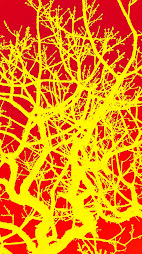We went to the crest of the hill at the top of Glen Quaich and this is the view that opened out in front of us across to the Cairngorm Range. It really was this good.
 Having eaten our butties we retreated back the way we had come as we were warned of the hill in front of us being blocked with snow and two cars being stuck!
Having eaten our butties we retreated back the way we had come as we were warned of the hill in front of us being blocked with snow and two cars being stuck!Not far back along the road this was the view that opened out so I just had to take a photo.
 Then came Loch Freuchie with this delightful island which I felt absolutely sure was a crannog. Here is the story to go with it which I discovered when I got home.
Then came Loch Freuchie with this delightful island which I felt absolutely sure was a crannog. Here is the story to go with it which I discovered when I got home.The crannog (man made island) on Loch Freuchie (Fraochie) has an interesting dragon legend?.. the story goes that a young man named Fraoch, at the request of the lady Maidh, went to the dragon inhabited island to gather rowan berries. He completed the task and evaded the dragon but the lady insisted that nothing would please her except that he return to her with the uprooted rowan tree. On his second visit he got the tree but awoke the dragon?. who, in mortal combat, gnawed off Fraoch's arms and legs?..
Amulree was at the junction of three major droves. It formed part of the route Highland drovers would use to bring their livestock to the cattle market at Crieff and Falkirk. Amulree Church was built between 1743 and 1752 and remodelled in 1882. Built to a simple design it has both a bellcote and wethervane. The architect was a John Douglas of Edinburgh. The Amulree church bell was cast in 1519. Amulree parish church contains copies of records of the large number of people who stayed in the area prior to mass emigration, mostly to North Easthope, Canada, in the early 19th Century. The Celtic place name was Ath Maol Ruibhe meaning Maol Rubha's ford.









4 comments:
All beautiful. The colours are fantastic.
welshcakes: Thanks.It really was a beautiful place.
What a stunning landscape - very powerful.
Thanks for taking me on a virtual tour.
moumntainear:I felt that we had stumbled into a very special valley and am glad that you liked it too.
Post a Comment